A recent investigation involving over 175,000 individuals across 25 nations has revealed that people in low—and middle-income countries encounter more significant challenges in their daily activities and are less inclined to use assistive devices than their counterparts in high-income countries. This revelation underscores concerns about the disproportionate global burden of disability, particularly prevalent in poorer regions.
Although global statistics show a decline in mortality and cardiovascular diseases, along with an extension in life expectancy, the health outcomes in less affluent nations remain substantially inferior to those in wealthier countries. The disparity in the prevalence of disabilities across various regions remains less explored. This pioneering prospective study surveyed participants on mobility, vision, and hearing limitations, discovering that such impairments are widespread, with mobility, bending, and visual challenges being the most common. Notably, one-third of the respondents reported experiencing at least one form of limitation, with older adults and women being the most affected groups.
The study revealed that limitations in daily activities are notably more prevalent in lower-income settings. Instances of walking and visual impairments are two and five times higher, respectively than in more affluent nations.
Raed Joundi, the study’s lead author and a researcher at the Population Health Research Institute (PHRI) of McMaster University and Hamilton Health Sciences, emphasised the scarcity of comprehensive data on activity limitations and their impact globally. The study aimed to bridge this gap by examining the frequency of fundamental activity limitations, the adoption of assistive technologies, and the resultant health outcomes across 25 countries.
As part of the extensive Prospective Urban Rural Epidemiological (PURE) study led by PHRI and Salim Yusuf, the senior scientist, the research was published in The Lancet on July 25, 2024. It gathered data from individuals aged between 35 and 70 using standardised questionnaires and monitored them over an average of 11 years, extending up to 20 years in some cases.
The findings also highlighted that simple yet essential assistive devices such as canes or glasses could significantly alleviate the daily challenges faced by individuals with disabilities. However, in poorer nations, the use of such basic aids was less than half that observed in wealthier countries.
Yusuf stressed the critical importance of access to assistive devices in enhancing the quality of life and enabling individuals to reach their potential despite disabilities. He pointed out the significant gap in access as a pivotal area for health policy and intervention in low—and middle-income countries.
Moreover, the research linked mobility restrictions with severe health issues, including elevated risks of mortality, cardiovascular diseases, pneumonia, and falls, underlining the profound impact of activity limitations on health.
Joundi called for developing policies and programmes to ensure disabled individuals in less affluent countries access essential assistive devices and other resources necessary for maintaining health. He also advocated for a deeper understanding of the factors leading to these limitations and the formulation of public health strategies to prevent them, aiming for a future where individuals can enjoy longer, healthier, and more fulfilling lives.
More information: Raed A Joundi et al, Activity limitations, use of assistive devices, and mortality and clinical events in 25 high-income, middle-income, and low-income countries: an analysis of the PURE study, The Lancet. DOI: 10.1016/S0140-6736(24)01050-X
Journal information: The Lancet Provided by McMaster University








